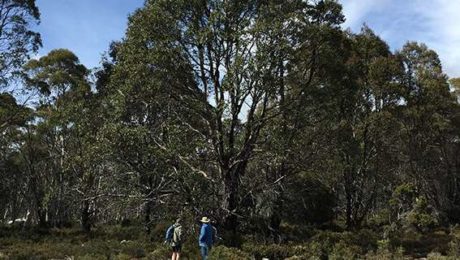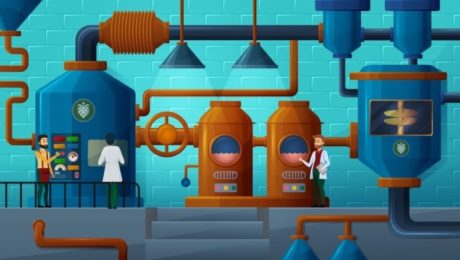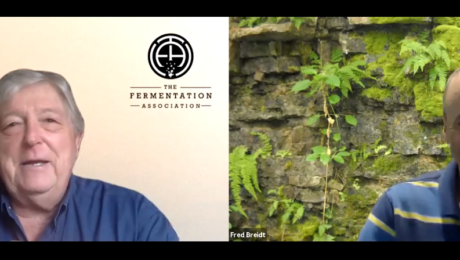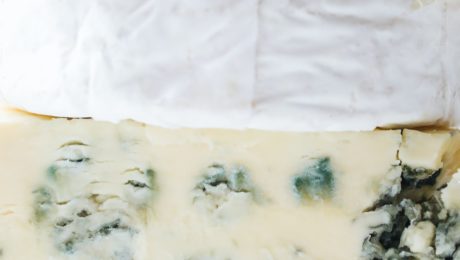The Science Behind Indigenous Wine
Australian wine scientists have published results of their research into the traditional practices Australian Aboriginal people used to make fermented beverages. Published in Scientific Reports, scientists from the University of Adelaide and the Australian Wine Research Institute (AWRI) “have discovered the complex microbial communities associated with the natural fermentation of sap from the iconic Tasmanian cider gum, Eucalyptus gunni.” The sweet sap from the trees produce a mildly alcoholic beverage when given time to spontaneously ferment.
Research leader Professor Vladimir Jiranek, Professor of Oenology with the University’s School of Agriculture, Food and Wine, says: “The wider community is not typically aware of these historic traditions. This work shines a light on these practices and the cultural significance of these unique fermentations. It also allows us to identify new strains, or species, of yeast and bacteria from the fermentations that are unique to Australia. Further work will characterize single microorganisms that have been isolated and grown from the cider gum. We are particularly interested in their fermentative abilities, their potential flavor impacts, how they’ve adapted to the cider gum environment and the possible symbiotic relationship they have with the trees. We look forward to continuing our work with relevant Aboriginal communities in order to understand these and other processes, and help revive lost practices or perhaps develop new ones from these.” (Phys.org) https://bit.ly/35eDgnr
- Published in Science
Alternative Protein Grows with Microbial Fermentation Technologies
Microbial fermentation is emerging as the “third pillar in the alternative protein industry,” alongside cell-culture and plant-based, according to the Good Food Institute. In 2020, protein alternatives made using microbial fermentation have attracted $435 million in investment capital. The institute released a 72-page report on fermentation in the alt protein industry and noted that its “potential is still largely untapped.” Nature Fynd CEO Thomas Jonas points out it takes years to grow animals, and months or years to grow plants, but microbes can double their biomass in a few hours. Are these novel fermentation techniques to produce animal-free meat and dairy improving our food system or too big of a departure from traditional fermentation?
Read more (Food Navigator)
- Published in Science
The New Taxonomy of Lactobacillus
Over several decades, the genus Lactobacillus became unmanageable, encompassing 262 species. Rudimentary research tools lumped any newly-discovered bacteria into the genus, making the taxonomy “very screwed up.”
“The lactobacillus taxonomy became a stack of dirty dishes — everyone knew somebody should do it, anyone could have done it, but nobody did it,” says Michael Gänzle, PhD, professor and Canada Research Chair in Food Microbiology and Probiotics at the University of Alberta. He spoke at a TFA webinar The New Taxonomy of Lactobacillus. “It has become very obvious that the genus is too diverse to group all or the organisms into a single genus. …We need taxonomy to actually describe which group of organisms they mean because if you say lactobacillus in the old sense, we mean a group of organisms that is so diverse that using the same genus name doesn’t make too much sense.”
The lactobacillus genus is large, regulated in many countries and economically important. Gänzle is one of 15 scientists involved in a year-long project using sophisticated DNA tools to analyze the new taxonomy. Findings’ published in the April issue of the Journal of Systematic and Evolutionary Microbiology, spread the species over 26 genera, including 23 new (novel) ones.
“The new taxonomy of lactobacilli means taxonomists have to navigate 23 new names, but maybe I can convince you that renaming the taxonomy is also the best thing since the invention of sliced bread because it does facilitate the communication on all things which relate to lactobacilli,” Gänzle says. He referred to the completed taxonomy as the “lactobacillus monster” because it covers 77 pages.
Despite its heft, he’s proud of the completed project, which reclassifies the genus into relevant groups. “It makes it easier to identify cultures of food applications,” Gänzle says. The group of authors also developed an online tool that makes it easy to look up old names and new names, and provides reference to (genome) sequence data at lactobacillus.ualberta.ca or lactobacillus.uantwerpen.be.
Ben Wolfe, PhD, Associate Professor at Tufts University, moderated the webinar. Wolfe studies the ecology and evolution of microbiomes in his lab (and is a TFA Advisory Board member).“It’s really great to see this community coming around this very important problem,” Wolfe says. “This really helps clarify a lot of things for us.
For the average artisanal fermented food producer, not much will change with the new taxonomy. Producers of traditionally fermented foods don’t put the organisms in their food or drink on their labels — it’s the companies selling starter cultures.
“For someone who doesn’t buy and sell cultures, this doesn’t change,” Gänzle adds. “There will be a transition period until everyone is familiar with the names and putting them on the label. Most, if not all, can still be abbreviated with L.”
- Published in Science
Introduction to HACCP
Creating a HACCP plan — a management system to control food preparation risk — can overwhelm food producers. But Charlie Kalish, food safety consultant and trainer, emphasizes HACCP (Hazard Analysis Critical Control Points) is vital to food safety.
“This is just as important as trying to understand, when I ferment things, why do I ferment? What are the things that get you excited about why you get the flavors that you get or the textures that you get (when you ferment)? The food safety thing, it’s really going to help you in the long run if you approach it with the same excitement because, if you don’t, it’s going to be a lot of work and it will drag you down,” Kalish says during the recent TFA webinar Introduction to HACCP. “I see a lot of people get bitter about (HACCP). ‘It’s such a drain on my resources and what I do!’ But it can help your product get better, it can help you get into new markets. And it is a different language, a different world. Even if you’re not going to get a PhD to understand the basic science underlying the mechanisms, having a strong control of HACCP, food safety, what the expectations are, it’s really going to help you.”
HACCP was originally created for the space program in the ‘60s. NASA needed a high level of assurance that food was going to be safe during missions in space, but traditional food models did not have enough preventive food safety controls. That plan was later adopted by the USDA and FDA to regulate food products.
“HACCP shifted the focus away from recalling food and trying to do damage control with outbreaks to preventing those things from happening in the first place,” Kalish says. “HACCP, in summary, is a systematic approach where we consider all of our ingredients, we consider every process step from when we receive our raw materials or ingredients all the way to the shipping out of our final product, it considers all reasonable and foreseeable hazards.”
Kalish points out HACCP controls for things with a high probability of occuring, like an E. Coli outbreak in lightly fermented food. And a good HACCP plan begins with a solid foundation, basic practices like regular hand washing, sanitizing surfaces and maintaining a comprehensive food safety employee training program.
“Common sense is an excellent guide to get you started for food safety, but I would further suggest to learn as much as you can: the science of the system you’re working with, the microbiology, pH, what it is, how you measure it,” says Fred Breidt, PhD, a microbiologist with the Agriculture Research Division of the USDA. Breidt joined Kalish during the webinar along with moderator Dave Ehreth, president of Sonoma Brinery; both are TFA advisory board members.
Luckily for fermenters, fermentation is a critical control point. In one study on kimchi by Breidt and his USDA colleagues, they found pH level is critical for food safety, a factor controlled by fermentation.
Though the internet can be a wonderful resource to find information on food safety, “you have to be judicious about your sources,” Breidt says. Kalish says to look for guidance from government sources, scientific literature, process authorities, university extension specialists, industry groups and publications or consultants.
Food producers need to budget for HACCP in their financial plan, Kalish advises. Ehreth agrees, and encourages producers still unsure of the process to pay a professional for help “to understand what potential biological hazards could be in that jar of food.”
“The modern food manufacturer is not only a food manufacturer, he is a protector and is entering into a bond of trust with his customers. And that bond of trust says ‘If you buy what I make, you’re not going to die as a result,” Ehreth adds. Though he notes it sounds like extreme advice, it’s a necessity for food producers to keep that creed at the forefront of their production.
- Published in Science
Coffee Conquers Colon Cancer?
A new study links drinking coffee to higher survival rates from colon cancer. Researchers found that in 1,171 patients treated for metastatic colorectal cancer, patients who drank two to three cups of coffee per day were likely to live longer. They also had a longer time before their disease worsened. Patients who drank four or more cups of coffee a day had an even greater benefit.
“It’s known that several compounds in coffee have antioxidant, anti-inflammatory, and other properties that may be active against cancer,” says Chen Yuan, study co-author and research fellow at the Dana-Farber Cancer Institute.
The study results, published in the peer-review journal JAMA Oncology, said coffee benefits were both for caffeinated and decaffeinated varieties. “Study authors emphasize the report was only able to find an association, not a cause-and-effect relationship. Experts say the study doesn’t provide sufficient evidence to recommend drinking coffee on a daily basis for people who have cancer.”
Read more (USA Today)
Development of Pickling Technologies & Products
There’s a void in scientific knowledge of fermented and pickled vegetables, and scientists are just starting to scratch the surface.
“We have a wealth of chemical compositions that we still don’t fully understand,” says Dr. Ilenyz Pérez-Díaz, PhD, a microbiologist with the USDA-ARS. Perez-Diaz presented on “Development of Pickling Technologies & Products” during a webinar hosted by TFA. “I honestly think there is still a lot to do in regards to the richness of the biological functions that are present in these systems. Every vegetable is different. … It will be fantastic to be able to comprehensively understand what’s really there and how we can use it for the benefit of not only processing but also for the benefit of human health.”
The purpose of the USDA-ARS is to find solutions for agricultural challenges, domestically and globally. In 2019, the 8,000 employees of the USDA-ARS researched 660 agricultural projects, filed 85 new patents, issued 65 new patents, received 51 new licenses and wrote 3,816 peer-reviewed journal articles.
Pérez-Díaz is assigned to the food science and market quality and handling research unit. There the team develops state-of-the-art, science-backed methods that improve the post-harvest processes, food preservation, food quality and safety and, ultimately, introducing nutritious products into the food system.
“What I love about the research that she’s doing is that pickling and fermentation are these ancient, traditional technologies that people have been using for hundreds and hundreds of years, and she’s really thinking about ways that we can advance those technologies using all the amazing sequencing and all the microbiology we have today,” says Ben Wolfe, PhD, associate professor of biology at Tufts University, and the TFA Advisory Board member who moderated the webinar.
Pérez-Díaz shared the USDA’s latest technologies to reduce food waste, lessen environmental impacts, improve water/energy demand and add more health value to preserved vegetables. Here are highlights from the research presented, focused on addressing two key problems:
Eliminate Salt in Cucumber Fermentation
PROBLEM: Sodium chloride is essential to fermentation, but the salt-rich (and sometimes preservative-filled) brine shipped from overseas producers can get into local freshwater supplies. There are no growers of small cucumbers (gherkins) in the U.S., so food projects that require small cucumbers must use overseas produce. But, in order for the cucumbers to be transported, they must be fermented or pickled. High amounts of salt, acid and sometimes preservatives are added, and these potentially can damage the water supply.
SOLUTION: USDA-ARS tested fermenting pickles using three popular spices: dill, cinnamon and mustard seed. But, though salt was reduced or eliminated, “the indigenious microbiota is always there,” Pérez-Díaz explains. “The salt is modulating the activity within this population. It tends to favor the lactic acid bacteria. But what I’ve learned is it is not the main factor modulating that microbiota. The ph and the production of that lactic acid and or acetic acid is really the factor in excluding the non desirable microorganisms and favoring the fermentative microbiota.”
Reduce Food Waste by Creating Foods
PROBLEM: In the U.S., between 30-70% of fresh vegetable produce is wasted. “Those are alarming numbers,” says Pérez-Díaz. “Even though they are estimates, it is necessary to look at ways to resolve the impact of such waste.”
SOLUTION: The USDA developed small-scale fermentation systems for use in restaurants, farmer’s markets and grocery stores. These vessels make fermenting excess food more manageable by allowing easy fermentation of smaller batches.
“We can convert what was waste or surplus or defective vegetables into a value-added product,” Pérez-Díaz says. “It will be a probiotic product, it will be fermented vegetables auxiliaries that can be used as sources of flavor, colors, ingredients in a number of recipes or even dehydrated for different applications.” [This project was near completion before the pandemic and is expected to pick-up soon.]
Fermentation, she emphasized, is needed to sustain a modern food system.
“These fermentations, if applied properly, they are very powerful eliminating the organisms that are not desirable or the organisms that are not of health significance,” Pérez-Díaz says. “I think fermentation will truly be an important component as we move forward to that new era.”
- Published in Science
Science Behind Fermented Vegetable Safety
Just because vegetables were fermented does not make them immune to harmful bacteria like E. coli. Though fermentation improves food safety, the quality of the raw vegetable before it’s fermented is extremely important.
“The issue of fermentation safety is one that comes up a lot. People are getting excited about the fermentation world these days, fermentation is increasing in popularity…(but) the wheels can fall off if you’re not careful,” says Fred Breidt, PhD, a USDA microbiologist. Breidt spoke during a recent webinar hosted by The Fermentation Association, “The Science Behind the Safety of Fermented Vegetables.” “The moral of the story: if the vegetables were safe to eat before you ferment them, they’re going to be safe to eat after you ferment them. If they’re not, you’ve got to ferment them for a long time to make sure they’re safe.”
An outbreak of dangerous bacteria in fermented vegetables, “it’s going to be pretty rare that that happens,” Breidt stresses. But, without proper sanitation protocol and vegetable quality control, pathogenic “bad guys” can flourish, like E. coli, salmonella and listeria. E. coli is more common in vegetables because it’s extremely acid resistant, and can survive for long periods of time at low pH levels and cold temperatures.
“Just washing the surface (of the vegetable) isn’t always going to do the trick,” Breidt says. “You don’t have to eat very much to get sick.”
An E. coli outbreak in kimchi made 230 Korean school children sick in 2013. The children, from seven different schools, all ate fermented kimchi made by the same manufacturer.
“If the folks had eaten the cabbage that this kimchi was made out of, they would have gotten sick as well,” Breidt says. “Was the cabbage improved in the sense of maybe it had fewer E. coli on it because of fermentation? Yes. But there was still enough when this was eaten to make a lot of people sick.”
“You can’t rely on salt for safety is the point,” he adds. “It does encourage the lactic acid bacteria and it helps them grow and it will increase overall the safety of your fermentation.”
David Ehreth, president and founder of Alexander Valley Gourmet, parent company of Sonoma Brinery, moderated the webinar. Ehreth first met Breidt when Sonoma Brinery made a few tons of sauerkraut that became infected with yeast. Ehreth says “I called Ghostbusters, and that’s Fred Breidt.” Though yeast is different from a pathogen like E. coli, Ehreth said Sonoma Brinery has managed to control yeast over the years by careful management of production techniques and improved sanitation methods.
- Published in Science
Healthy Cheese?
“Cheese is finding new ground as a ‘health’ food,” writes John Lucey, professor of food science at the University of Wisconsin, Madison and the director of the Center for Dairy Research. Cheese has received a bad stereotype as a dairy food high in saturated fat and carbs, but Lucey notes cheese is high in vitamin C, riboflavin, vitamin B12 and folate. Studies show fermented cheeses reduce cancer rates, and fermented cheese contains bioactive peptides that reduce blood pressure, enhance the immune system and improve cardiovascular health.
Read more (Dairy Foods)
Microbes & Fermented Sausages
Microbes in “starter cultures” impart a distinctive tang and longer shelf life to food like sourdough bread, yogurt and kimchi through the process of fermentation. To get a better grasp of how microbes do this in fermented sausages, such as chorizo and pepperoni, researchers reporting in the Journal of Agricultural and Food Chemistry carefully show that these tiny organisms change the composition of fatty acids in these meats, contributing to many desirable traits.
Fatty acids and related compounds can influence the quality of fermented foods. For example, one species of bacteria in sourdough cultures produces a type of fatty acid that increases bread’s resistance to mold. Scientists, however, haven’t had a good handle on how specific cultures drive the formation of these and other similar compounds in meat, partially because some of the previous studies on meats have not included a bacteria-free control. To better understand the link between microbes and molecules, Nuanyi Liang and colleagues wanted to see how the production of fatty acids within sausages varied depending on the microbial culture used to ferment it.
To do so, they prepared the meat three ways. In one method, they included only the bacterium Latilactobacillus sakei; in another preparation, they used both L. sakei and Staphylococcus carnosus. Both of these samples were made in such a way as to prevent contamination from bacteria in the environment. They treated the third sample — the control — with an antibiotic solution to eliminate the microbes naturally living within the sausage. Over the course of 20 days, they checked the sausages and found a markedly different profile for microbe-free sausage compared to the sausage containing either of the two microbial cultures. For example, the researchers observed that linolenic acid, an unsaturated fatty acid, was accumulating in the microbe-free sausage but not in the cultured sausage. Differences emerged between the two sets of microbes as well, with the sausage containing the L. sakei culture alone, for example, producing higher levels of coriolic acid, which has antifungal activity and, at higher concentrations, also imparts bitter taste. A better understanding of the biochemistry by which microbes influence the quality of sausage and other fermented foods will aid the production of consistent, long-lasting and good-tasting products, the researchers say.
The authors acknowledge funding from the Natural Sciences and Engineering Research Council of Canada Discovery and CREATE programs, the University of Alberta’s Meat Education and Training Network, the Canada Research Chairs program and Mitacs.
- Published in Science
Pandemic Disrupts Academic Fermentation Research Worldwide
By Neal Vitale
Universities across the globe are struggling not only with how to educate incoming and returning students but with safe reopening of their research labs. Much of their focus is on the same approaches broadly recommended by health officials – social distancing, mandatory face masks, daily health screening and contact tracing.
“It’s been a ton of work for everyone – intellectually to develop new policies, physically to rearrange and manage buildings and administratively to manage work calendars and class schedules across a large campus,” says Abigail Snyder, assistant professor of microbial food safety at Cornell University. “Besides the resources involved in getting these plans off the ground, these policies necessarily mean that we’re operating at reduced in-person capacity and that there are budgetary shortfalls.”
Professor of Food Science at the University of Nebraska-Lincoln Bob Hutkins reports similar disruption.
“Just like everywhere, my lab shut down in late March. Only a few critical functions were maintained, but lab research was effectively halted,” Hutkins says. “Some of my graduate students, however, also perform computational research analyzing microbiome data, so those projects were less affected. Still, the two projects that were most lab-oriented happened to be focused on fermented foods. Our lab did reopen in late June, so we are now (after a 3-month delay) almost back to where we were pre-COVID.”
Maria Marco, professor in food science and technology at the University of California, Davis, (and member of the TFA Advisory Board) adds: “As the pandemic continues there is an increasing financial and emotional toll on graduate students and postdocs whose research is now significantly delayed. This toll also applies to new students. I have a new international graduate student who is supposed to start work on a food fermentation project this fall but may not receive a visa to come to the US. Although she can contribute remotely, this barrier would cause significant hardship and prolong the time needed to complete the degree.”
The situation obviously remains fluid, as noted by Barbara Ingham, professor of food science, University of Wisconsin-Madison.
“Things are changing pretty much on a weekly basis here,” Ingham says. “We were to move to Phase 2 in July; that is on indefinite hold. Our campus teaching schedule changes on a weekly (and sometimes daily) basis, etc. It’s hard to be up-to-date at this time.”
Professor of Foods and Nutrition and Extension Food Safety Specialist Elizabeth Andress at the University of Georgia echoes these themes.
“[The work] I was doing on coming up with home-based or small entrepreneur kimchi and sauerkraut variations that I was willing to put the UGA Extension name on to publicly release was ground to a halt this past winter/spring,” Andress says. “And I haven’t been back on campus since mid-February because of a fall injury followed by the pandemic restrictions, let alone reduced budgets are now not going to allow employment of help or any significant research that was self-funded pre-COVID. …policies for finding ways to do non-essential research and have multiple people in a lab are still undergoing constant new messaging and planning at UGA.”
A somewhat more positive picture emerges from Canada. Michael Ganzle is professor and Canada research chair in microbiology and probiotics at the University of Alberta.
“Fermented food products including (sourdough) bread are not on the list of products with reduced demand during the COVID-crisis. To the opposite, many started making sourdough bread during the lockdown in Alberta, and I have been contacted by many (including TV and radio stations) on how to manage with sourdough,” Ganzle adds. “Research at UAlberta was temporarily reduced due to lockdowns of some services on campus, and reduced capacity/increased safety rules, but [research] never really stopped. With one exception, extramurally funded projects or graduate thesis projects were somewhat delayed but timelines were not substantially disrupted. The picture is different for anyone using animals or humans in their research projects, or those doing field research – these ramp up only now after a three month interruption.”
He attributes the relatively modest impact of the COVID-19 pandemic on research activities to appropriate leadership at the department/university/provincial (state) level that appeared to strike an appropriate balance of safety measures to “flatten the curve” with ongoing research/economic activity.
Snyder at Cornell also underscores the efforts being aimed at facilitating both the advancement of teaching and research missions as well as supporting robust protection of public health. “In truth, I wish we had policies like these generalized more broadly across the US.”
Adds Hutkins at University of Nebraska,”As inconvenient as the shutdown has been, the main issues for my colleagues and me have been to ensure that the lab remains a safe environment, that we practice social distancing and that students and staff stay physically and emotionally healthy.”
- Published in Science










